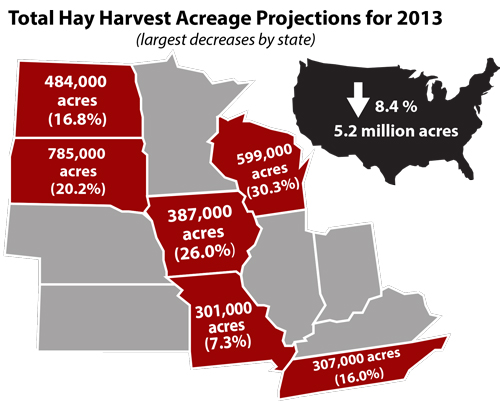Regional Changes in Hay Production Already Happening

By Derrell S. Peel, Oklahoma State University Extension Livestock Marketing Specialist
Harvested hay acreage has changed in recent years, and it goes beyond the drought impacts of the past two years.
Lingering winter weather this year is exaggerating the impacts of limited forage supplies for beef producers. Drought in 2011 and 2012 reduced U.S. hay production and increased hay demand, leaving the country with very limited forage supplies at this time. On December 1, stocks of all hay were down nearly 28% from a 2001-2010 average prior to the drought. States with the biggest decrease in hay stocks are (in descending order);
- Texas
- South Dakota
- Missouri
- Kansas
- Iowa
- Wisconsin
- Oklahoma
- Arkansas
- Nebraska
- Michigan
- Minnesota
These 11 states all had reductions in hay stocks of 1 million tons or more and accounted for 72% of the total decrease in December 1 hay stocks compared to the 2011-2010 average. Decreased hay stocks for Texas, South Dakota, Missouri and Kansas all exceeded 2 million tons.
Drought reduced hay production in many states in either 2011 or 2012 or both. The 2011-2012 average all hay production for the U.S. was down 16% from the 2001-2010 average. A comparable list of the top 11states with decreased 2011-2012 average all hay production is the same as above for hay stocks with two exceptions; South Dakota and Minnesota are not in the top 11 decreased hay production states and are replaced on the list by California and Ohio. South Dakota did have sharply reduced hay production in 2012 but it followed high production in 2011 so the two-year average was only 9% below the 2001-2010 average. Compared to the 2001-2010 average, the 11 states with the biggest decrease in 2011-2012 production accounted for 77% of the total U.S. decrease in production.
Drought generally has a bigger impact on hay yields compared to harvested acreage. The recent USDA-NASS report on prospective plantings also included estimated hay harvested acreage for 2013. A look at how harvested hay acreage has changed in recent years indicates changes in hay production that go beyond the drought impacts of the past two years.

Compared to the 10 year pre-drought average (2001-2010), total hay harvested acreage for 2013 is projected to be down by 8.4%, a decrease of 5.2 million acres. The largest decreases by state include:
- South Dakota, down 785,000 acres (20.2%)
- Wisconsin, down 599,000 acres (30.3%)
- North Dakota, down 484,000 acres (16.8%)
- Iowa, down 387,000 acres (26%)
- Tennessee, down 307,000 acres (16%)
- Missouri, down 301,000 acres (7.3%)
Rounding out a similar top 11 list includes the states of Minnesota, Pennsylvania, Kansas, Kentucky and Ohio, all with decreased hay harvested acreage of 200,000 to 300,000 acres compared to the 2001-2010 average. Together these states account for 79% of the decrease in total U.S. hay harvested acreage.
Most of these changes in hay harvested acreage are not the impact of drought but rather reflect longer term shifts in crop production. Significant amounts of hay land are being converted to annual crop production in and around the Corn Belt from North Dakota to Tennessee. The decrease in hay harvested acreage in the Northern Plains and Upper Midwest is particularly dramatic. By contrast, some of the worst drought affected areas, including Texas and Oklahoma, have projected 2013 hay harvested acreage that is unchanged or up from the 10-year average.







